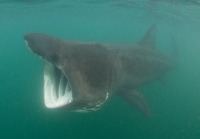
(Photo: Claire Goodwin)
Basking Shark
Cetorhinus maximus
Dark grey-blue shark with a distinct pointed snout. Their gill slits extend from the top of their head to the bottom, almost encircling the entire head. Their caudal (tail) fin has a crescent shape and a pronounced keel (ridge). They are the second largest fish in the world after the whale shark and can reach lengths of 10 metres. They may live up to 50 years.
Authority
Gunnerus, 1765
Classification Details
Phylum: Chordata (chordates); Subphylum: Vertebrata (vertebrates); Class: Elasmobranchii (sharks, skates, and rays).
Habitat
Basking sharks are found worldwide, usually in waters between 6°C and 16°C. In Canadian waters, they are most often seen in the summer and fall around the coastline. They are present on the east coast of Canada from Newfoundland to the Bay of Fundy.
Diet
Filter feeders. Water enters the body via the mouth and flows out over the gills. During this process, the gill rakers capture planktonic prey, including crustaceans, fish larvae, and fish eggs.
Reproduction
Sexes are separate. Females reach maturity around 18 years. Fertilization is internal via claspers. Basking sharks are ovoviviparous. This means they have eggs that hatch within the body and then the mother gives birth to live young. They have a gestation period of two to three years and give birth to up to six pups which are 1.5 to 1.7 metres long. Oophagy occurs inside the mother (pups will eat other ova after absorbing their yolk sac).
Fun Facts
Basking sharks used to be caught for their livers. People used oil from the liver for lamp oil and for lubricating machinery. A single shark could yield 750 to 1 500 litres of oil. Fortunately, there are now synthetic alternatives and basking sharks are no longer fished in Canada.
References
Campana S, Gibson J, Brazner J, Marks L, Joyce W, Gosselin J-F, Kenney RD, Shelton P, Simpson M, Lawson J (2008) Status of basking sharks in Atlantic Canada. Canadian Science Advisory Secretariat Research Document 2008/04.
Froese R and Pauly D (2019) FishBase. Cetorhinus maximus, Basking shark. http://www.fishbase.org/summary/90 Accessed 20 online January 2020.
Skomal G (2016) The Shark Handbook. 2nd edition. Kennebunkport: Cider Mill Press Book Publishers.


